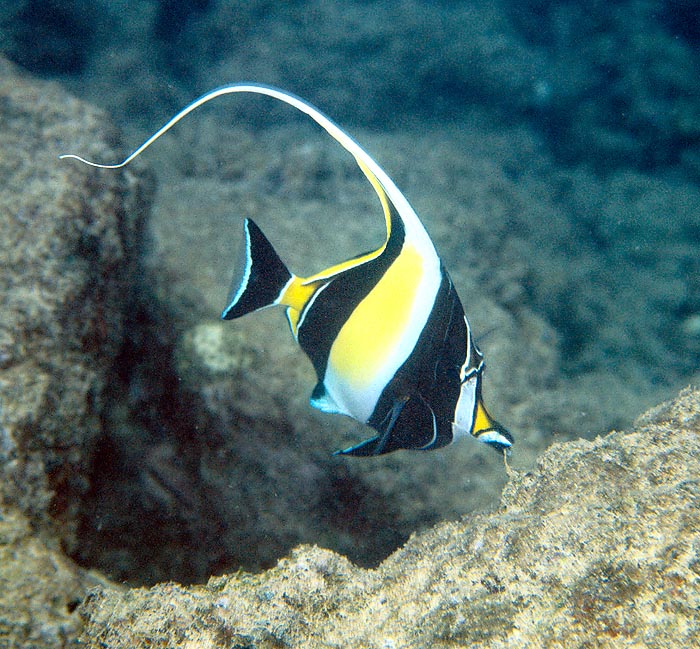Family : Zanclidae

Text © DrSc Giuliano Russini – Biologist Zoologist

English translation by Mario Beltramini

Adult Zanclus cornutus eating algae along Sri Lanka coasts © Giuseppe Mazza
Taxonomically, this fish and the other species are afferent to the class of the Actynopterygii, order Perciformes, family Zanclidae and genus Zanclus.
More precisely, till several years ago, it was generally thought that the species of the genus Zanclus were two, the Zanclus canescens and the Zanclus cornutus.
Nowadays, on the contrary, we are almost convinced that in reality, there is only one species: the Zanclus cornutus.
This concept is still not accepted by all; some biologists say that the difference the others were pointing out in the past comes from the sex; the International Code for Zoological Nomenclature (ICZN), for the moment accepts the species Zanclus cornutus.
Zoogeography
The zanclids, and therefore also the moorish idol, which, by some Muslim ethnic groups is considered as a sacred fish, live in the coastal waters of the tropical seas. They may be found in the Indian Ocean, the southern Atlantic, the Red Sea, but are mainly present in the tropical waters of the Pacific Ocean.
Ecology-Habitat
They mainly frequent the reefs rich of vegetation (algae, marine phanerogams), venturing also inside the mangroves.
Their diet is essentially vegetarian, not too frequent particularity in the marine fish species; on the other hand the too narrow mouth and the teeth they have would make very difficult for them to seize animal preys, however small the might be.
Morpho-physiology
The Zanclidae form a minor family as number of species, intermediate for various characters between the extremely elegant Chaetodontids (Chaetodontidae), and the Acanthurids (Acanthuridae), otherwise known as surgeonfishes.

Zanclidae form a family intermediate for various characters between the elegant Chaetodontids, the butterfly fish, and the Acanthurids, the surgeonfishes © Giuseppe Mazza
The general lines of the zanclids tell us that, like the Chaetodontids and the acanthurids, they have a strongly laterally compressed body and quite tall, with very narrow and elongated dorsal and anal fins. The palate has no teeth. Unlike the other two families, the zanclids, and therefore the moorish idol, have a tubular snout, ending in a very small mouth.
A similar character is found only, and even rarely, among the chaetodontids, which, even if smaller than the zanclids, are however paradoxically less related systematically than what are the acanthurids. In fact, anatomically, these last have thorny rays of the fins less developed and in a lesser number, thus evidencing a taxonomic affinity. The Zanclus cornutus, in the shape of the body and the colouration of the livery, at a first glance reminds more the Pennant coralfish (Heniochus acuminatus), one of the most diffused ornamental species.
The moorish idol has a very long dorsal fin prolonged in a filament bent backwards; shorter, even if remarkably developed, is the anal fin, which does not have a similar appendix. The tail, inserted in a quite narrow peduncle is posteriorly very enlarged and truncated at the apex.

Young captive specimen. They are herbivorous and delicate fishes to be left to big public aquaria © G. Mazza
On the front protuberance of the snout, similar to a beak, we may see two dark stripes separated by an oblique pale zone. On the body, on the contrary, the vertical dark stripes are two and are well spaced. The first, ampler and more ahead, covers also the eyes, the opercular region and the vertical fins, blackish too; the second one, on the contrary, occupies the back half of the anal fin and from here, through the body, reaches the back half of the dorsal.
A dark stripe covers also almost all the tail, which has, however, the back edge of white colour. The dimensions are average, but relatively big for an ornamental species: the length of the body may in fact attain the 20 cm, whilst there are at least thirty centimetres between the apex of the anal fin and that of the dorsal one.
Ethology-Reproductive Biology
It is a very delicate and friendly fish. It needs temperatures of 25-29 °C. In aquarium, it is suitable for living together with reef fishes of other species, such as those afferent to the family of the Acanthurids. There have never been cases of interspecific hybridization.
When captive, it needs constant additions in water of trace elements and of bioelements, in order to improve its resistance to the fungal and protozoic deseases, and, especially, it is necessary to furnish it of vegetables, such as boiled spinaches. It swims with alternate strokes of the pectoral fins. Till now, there is no information and data about its reproduction, even if many ichthyological biologists suspect an external reproduction. The vulnerability index of this species is of 12 over 100.
Synonyms
Chaetodon canescens Linnaeus, 1758; Chaetodon cornutus Linnaeus, 1758; Zanclus canescens Linnaeus, 1758; Zanclus cornotus Linnaeus, 1758.
→ For general information about FISH please click here.
→ For general information about BONY FISH please click here
→ For general information about CARTILAGINOUS FISH please click here.
→ To appreciate the BIODIVERSITY of BONY FISH please click here.
→ To appreciate the BIODIVERSITY of CARTILAGINOUS FISH please click here.
